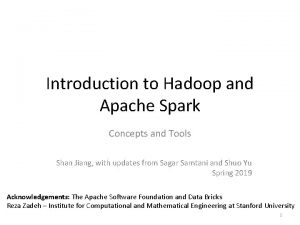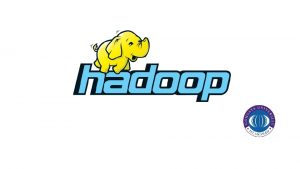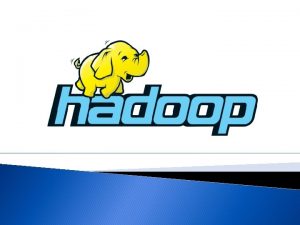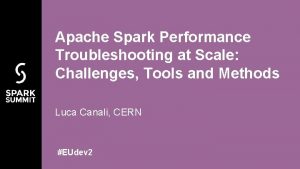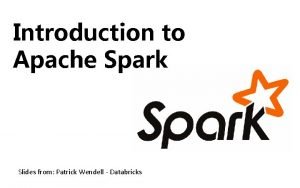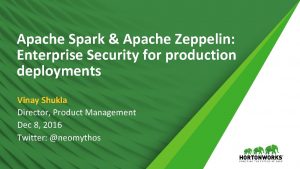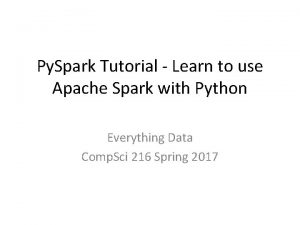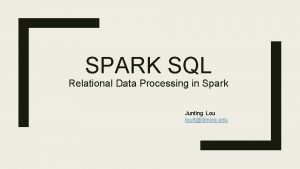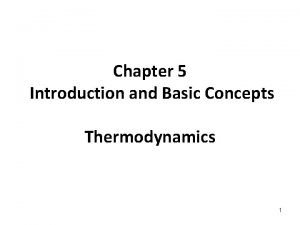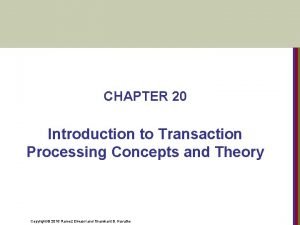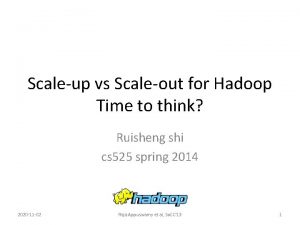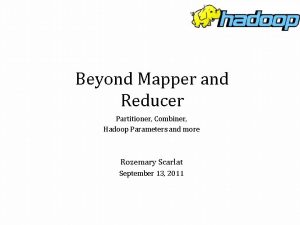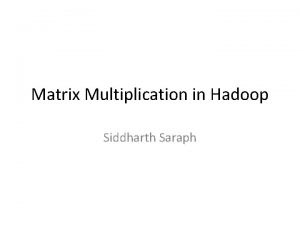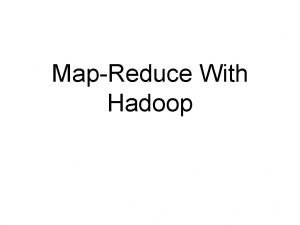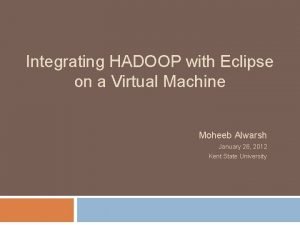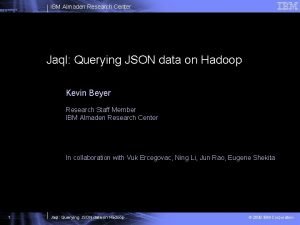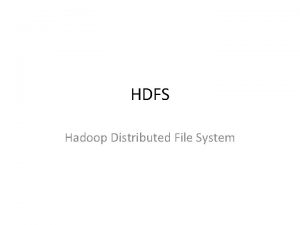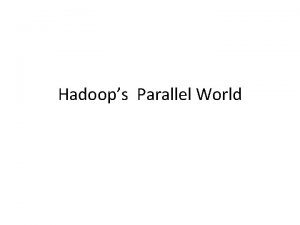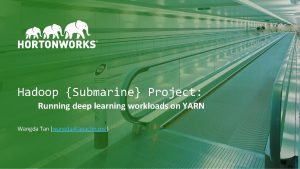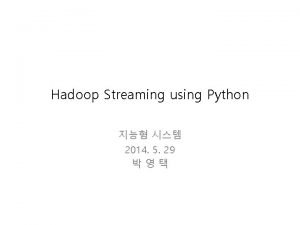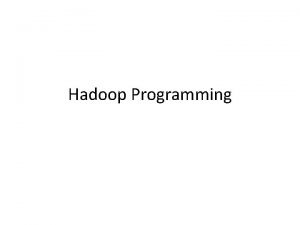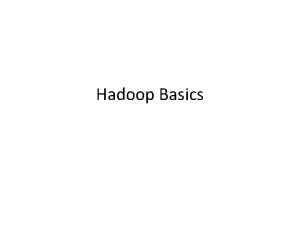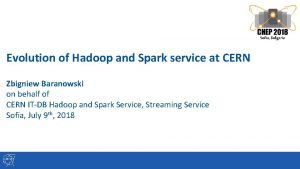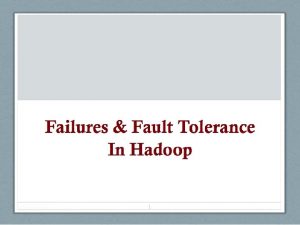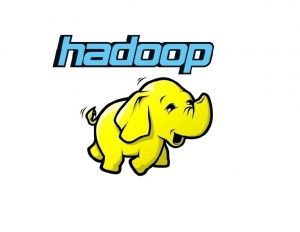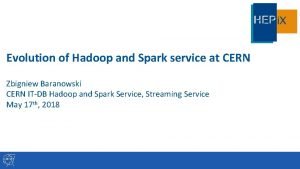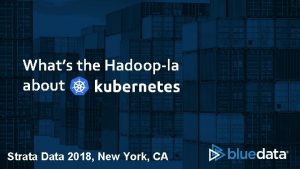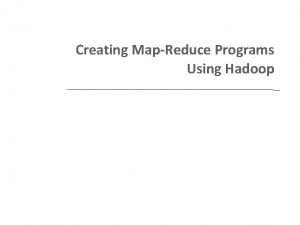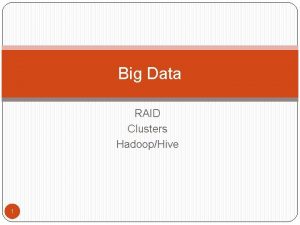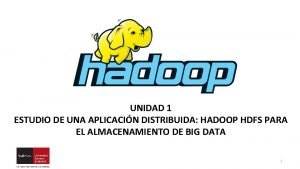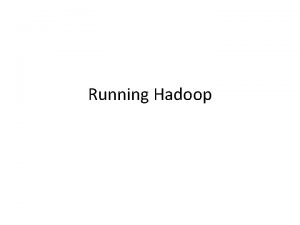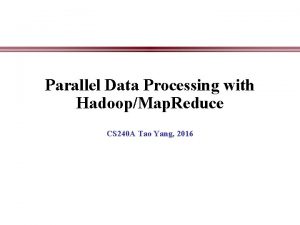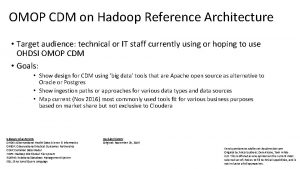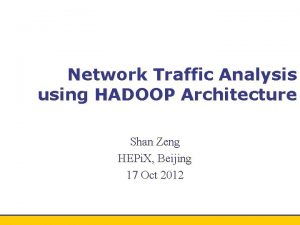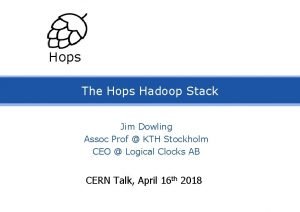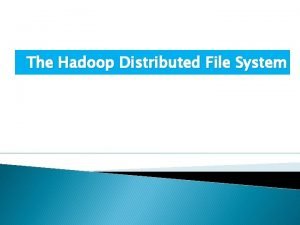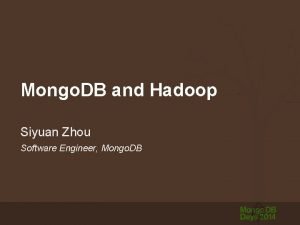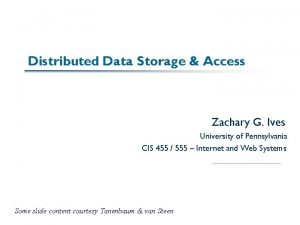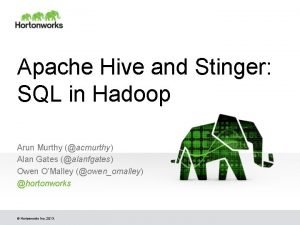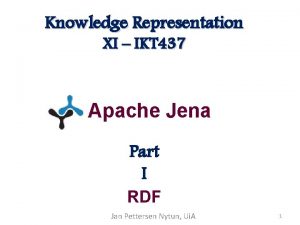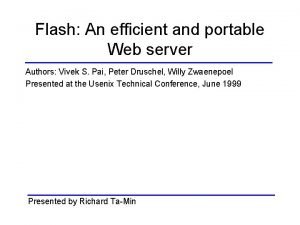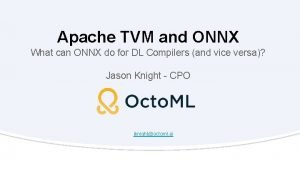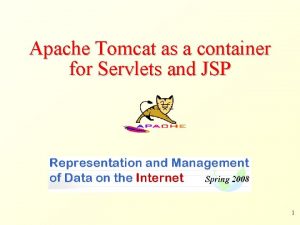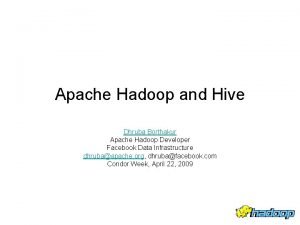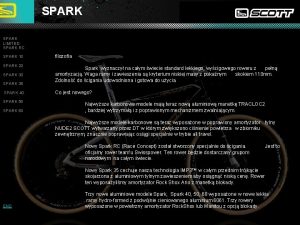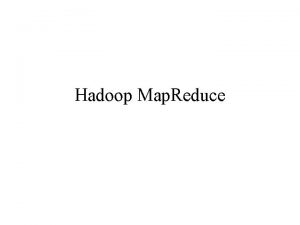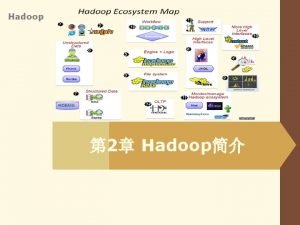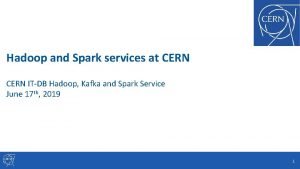Introduction to Hadoop and Apache Spark Concepts and







































































































- Slides: 103

Introduction to Hadoop and Apache Spark Concepts and Tools Shan Jiang, with updates from Sagar Samtani and Shuo Yu Spring 2019 Acknowledgements: The Apache Software Foundation and Data Bricks Reza Zadeh – Institute for Computational and Mathematical Engineering at Stanford University 1

Outline • • Overview What and Why? Map. Reduce Framework HDFS Framework How? Hadoop Mechanisms Relevant Technologies Apache Spark Tutorial on Amazon Elastic Map. Reduce } 2

Overview of Hadoop 3

Why Hadoop? • Hadoop addresses “big data” challenges. • “Big data” creates large business values today. – $34. 9 billion worldwide revenue from big data analytics in 2017*. • Various industries face “big data” challenges. Without an efficient data processing approach, the data cannot create business values. – Many firms end up creating large amounts of data that they are unable to gain any insight from. *https: //wikibon. com/wikibons-2018 -big-data-analytics-market-sharereport/ 4

Big Data Facts • KB MB GB TB PB EB ZB YB 100 TB [100 TB] of data uploaded daily to Facebook. 235 TB [235 TB] of data has been collected by the U. S. Library of Congress in April 2011. • Walmart handles more than 1 million customer transactions every hour, which is more than 2. 5 PB [2. 5 PB] of data. • Google processes [20 PB] of data per day. 20 PB • [2. 7 ZB] of data exist in the digital universe today. 2. 7 ZB • • 5

Why Hadoop? • Hadoop is a platform for storage and processing huge datasets distributed on clusters of commodity machines. • Two core components of Hadoop: – Map. Reduce – HDFS (Hadoop Distributed File Systems) 6

Core Components of Hadoop 7

Core Components of Hadoop • Map. Reduce – An efficient programming framework for processing parallelizable problems across huge datasets using a large number of commodity machines. • HDFS – A distributed file system designed to efficiently allocate data across multiple commodity machines, and provide self-healing functions when some of them go down. Performance Cost Availability Commodity machine Super computer Low Readily available High Hard to obtain 8

Hadoop vs. Map. Reduce • They are not the same thing! • Hadoop = Map. Reduce + HDFS • Hadoop is an open source implementation based on Google Map. Reduce and Google File System (GFS). 9

Hadoop vs. RDBMS • Many businesses are turning from RDBMS to Hadoop-based systems for data management. Hadoop-based RDBMS Data format Structured & Unstructured Mostly structured Scalability Very high Limited Speed Fast for large-scale data Very fast for small-medium size data. Analytics Powerful analytical tools for Some limited built-in analytics. big data. • In a word, if businesses need to process and analyze large-scale, real-time data, choose Hadoop. Otherwise staying with RDBMS is still a wise choice. 10

Hadoop vs. Other Distributed Systems • Common Challenges in Distributed Systems – Component Failure • Individual computer nodes may overheat, crash, experience hard drive failures, or run out of memory or disk space. – Network Congestion • Data may not arrive at a particular point in time. – Communication Failure • Multiple implementations or versions of client software may speak slightly different protocols from one another. – Security • Data may be corrupted, or maliciously or improperly transmitted. – Synchronization Problem – …. 11

Hadoop vs. Other Distributed Systems • Hadoop – Uses efficient programming model. – Efficient, automatic distribution of data and work across machines. – Good in component failure and network congestion problems. – Weak for security issues. 12

HDFS 13

HDFS Framework • Hadoop Distributed File System (HDFS) is a highly fault-tolerant distributed file system for Hadoop. – Infrastructure of Hadoop Cluster – Hadoop = Map. Reduce + HDFS • Specifically designed to work with Map. Reduce. • Major assumptions: – Large data sets – Hardware failure – Streaming data access 14

HDFS Framework • Key features of HDFS: – – Fault Tolerance - Automatically and seamlessly recover from failures Data Replication - to provide redundancy. Load Balancing - Place data intelligently for maximum efficiency and utilization Scalability - Add servers to increase capacity – “Moving computations is cheaper than moving data. ” 15

HDFS Framework • Components of HDFS: – Data. Nodes • Store the data with optimized redundancy – Name. Node • Manage the Data. Nodes 16

Map. Reduce Framework 17

Map. Reduce Framework • Map: – Extract something of interest from each chunk of record. • Reduce: General framework – Aggregate the intermediate outputs from the Map process. • The Map and Reduce have different instantiations in different problems. 18

Map. Reduce Framework • Outputs of Mappers and inputs/outputs of Reducers are key-value pairs <k, v>. • Programmers must do the coding according to the Map. Reduce Model – Specify Map method – Specify Reduce method – Define the intermediate outputs in <k, v> format. 19

Map. Reduce Framework 20

Example: Word. Count • A “Hello. World” problem for Map. Reduce. • Input: 1, 000 documents (text data). • Job: Count the frequency of each word. – Too slow to do on one machine. • Each Map function produces <word, 1> pairs for its assigned task (say, 1, 000 documents) document 1: a dog ran into a cat. document 2: …. . …… Map <a, 1> <dog, 1> <ran, 1> <into, 1> <a, 1> <cat, 1> …… 21

Example: Word. Count • Each Reduce function aggregates <word, 1> pairs for its assigned task. The task is assigned after map outputs are sorted and shuffled. <a, 1> <dog, 1> <into, 1> <a, 1> <dog, 1> <cat, 1> <dog, 1> …… Reduce <a, 4> <cat, 1> <dog, 3> <into, 1> …… • All Reduce outputs are finally aggregated and merged. 22

Hadoop Mechanisms 23

Hadoop Architecture • Hadoop has a master/slave architecture. • Typically one machine in the cluster is designated as the Name. Node and another machine as the Job. Tracker, exclusively. – These are the masters. • The rest of the machines in the cluster act as both Data. Node and Task. Tracker. – These are the slaves. 24

Hadoop Architecture • Example 1 Masters Job Tracker Name. Node 25

Hadoop Architecture • Example 2 (for small problems) 26

Hadoop Architecture • Name. Node (master) – Manages the file system namespace. – Executes file system namespace operations like opening, closing, and renaming files and directories. – It also determines the mapping of data chunks to Data. Nodes. – Monitor Data. Nodes by receiving heartbeats. • Data. Nodes (slaves) – Manage storage attached to the nodes that they run on. – Serve read and write requests from the file system’s clients. – Perform block creation, deletion, and replication upon instruction from the Name. Node. 27

Hadoop Architecture • Job. Tracker (master) – – – Receive jobs from client. Talks to the Name. Node to determine the location of the data Manage and schedule the entire job. Split and assign tasks to slaves (Task. Trackers). Monitor the slave nodes by receiving heartbeats. • Task. Trackers (slaves) – Manage individual tasks assigned by the Job. Tracker, including Map operations and Reduce operations. – Every Task. Tracker is configured with a set of slots, these indicate the number of tasks that it can accept. – Send out heartbeat messages to the Job. Tracker to tell that it is still alive. – Notify the Job. Tracker when succeeds or fails. 28

Hadoop program (Java) • Hadoop programs must be written to conform to Map. Reduce model. It must contain: – Mapper Class • Define a map method – map(KEY key, VALUE value, Output. Collector output) or map(KEY key, VALUE value, Context context) – Reducer Class • Define a reduce method – reduce(KEY key, VALUE value, Output. Collector output) or reduce(KEY key, VALUE value, Context context) – Main function with job configurations. • Define input and output paths. • Define input and output formats. • Specify Mapper and Reducer Classes 29

Hadoop program (Java) 30

Example: Word. Count • Word. Count. java 31

Example: Word. Count (cont’d) • Word. Count. java 32

Where is Hadoop going? • Hadoop 3. 0 has been released in December 2017. – HDFS supports erasure code, saving a half of storage space. – Map. Reduce performance improvement by 30% – Less stable 33

Relevant Technologies 34

Technologies relevant to Hadoop Zookeeper Pig 35

Hadoop Ecosystem 36

Sqoop • Provides simple interface for importing data straight from relational DB to Hadoop. 37

No. SQL • HDFS: Append-only file system – A file once created, written, and closed need not be changed. – To modify any portion of a file that is already written, one must rewrite the entire file and replace the old file. – Not efficient for random read/write. – Use relational database? Not scalable. • Solution: No. SQL – Stands for Not Only SQL. – Class of non-relational data storage systems. – Usually do not require a pre-defined table schema in advance. 38

No. SQL • Motivations of No. SQL – Simplicity of design – Simpler “horizontal” scaling – Finer control over availability • Compromise consistency in favor of availability, partition tolerance, and speed. – Many No. SQL databases do not fully support ACID • Atomicity, consistency, isolation, durability 39

No. SQL • No. SQL data store models: – – Key-Value store Document store Wide-column store Graph store {“id”: “ 2019000001”, “name”: “i. Phone”, “model”: “XR”, “sale. Date”: “ 01 -JAN-2019”, . . . } • No. SQL Examples: – Mongo. DB – HBase – Cassandra • Its suitability depends on the problem. – Good for big data and real-time web applications 40

HBase • HBase – Hadoop Database. • Good integration with Hadoop. – A datastore on HDFS that supports random read and write. – A distributed database modeled after Google Big. Table. – Best fit for very large Hadoop projects. 41

Comparison between No. SQLs • The following articles and websites provide a comparison on pros and cons of different No. SQLs – Articles • http: //blog. markedup. com/2013/02/cassandra-hive-andhadoop-how-we-picked-our-analytics-stack/ • http: //kkovacs. eu/cassandra-vs-mongodb-vs-couchdb-vsredis/ – DB Engine Comparison • http: //db-engines. com/en/systems/Mongo. DB%3 BHBase 42

Need for High-Level Languages • Hadoop is great for large data processing! – But writing Mappers and Reducers for everything is verbose and slow. • Solution: develop higher-level data processing languages. – Hive: Hive. QL is like SQL. – Pig: Pig Latin is similar to Perl. 43

Hive • Hive: data warehousing application based on Hadoop. – Query language is Hive. QL, which looks similar to SQL. – Translate Hive. QL into Map. Reduce jobs. – Store & manage data on HDFS. – Can be used as an interface for HBase, Mongo. DB etc. 44

Hive Word. Count. hql 45

Pig • A high-level platform for creating Map. Reduce programs used in Hadoop. • Translate into efficient sequences of one or more Map. Reduce jobs. • Execute the Map. Reduce jobs. 46

Pig Word. Count. hql • A = load '. /input/'; B = foreach A generate flatten(TOKENIZE((chararray)$0)) as word; C = group B by word; D = foreach C generate COUNT(B), group; store D into '. /wordcount'; 47

Mahout • A scalable data mining engine on Hadoop (and other clusters). – “Weka on Hadoop Cluster”. • Steps: – 1) Prepare the input data on HDFS. – 2) Run a data mining algorithm using Mahout on the master node. 48

Mahout • Mahout currently has Collaborative Filtering. User and Item based recommenders. K-Means, Fuzzy K-Means clustering. Mean Shift clustering. Dirichlet process clustering. Latent Dirichlet Allocation. Singular value decomposition. Parallel Frequent Pattern mining. Complementary Naive Bayes classifier. Random forest decision tree based classifier. High performance java collections (previously colt collections). A vibrant community. and many more cool stuff to come by this summer thanks to Google summer of code. – …. – – – – 49

Zookeeper • Zookeeper: A cluster management tool that supports coordination between nodes in a distributed system. – When designing a Hadoop-based application, a lot of coordination works need to be considered. Writing these functionalities is difficult. • Zookeeper provides services that can be used to develop distributed applications. • Zookeeper provide services such as : Configuration management Synchronization Group services Leader election …. Who use it? Hbase Cloudera … 50

Cloudera • A platform that integrates many Hadoopbased products and services. 51

• Hadoop is powerful. But where do we find so many commodity machines? 52

Amazon Elastic Map. Reduce • Setting up Hadoop clusters on the cloud. • Amazon Elastic Map. Reduce (AEM). – Powered by Hadoop. – Uses EC 2 instances as virtual servers for the master and slave nodes. • Key Features: – No need to do server maintenance. – Resizable clusters. – Hadoop application support including HBase, Pig, Hive etc. – Easy to use, monitor, and manage. 53

References • These articles are good for learning Hadoop. – http: //developer. yahoo. com/hadoop/tutorial/ – https: //hadoop. apache. org/docs/r 1. 2. 1/mapred_t utorial. html – http: //www. michael-noll. com/tutorials/ – http: //www. slideshare. net/cloudera/tokyonosqlslidesonly – http: //www. fromdev. com/2010/12/interviewquestions-hadoop-mapreduce. html 54

Apache Spark 55

Apache Spark Background • Many of the aforementioned Big Data technologies (Hbase, Hive, Pig, Mahout, etc. ) are not integrated with each other. • This can lead to reduced performance and integration difficulties. • However, Apache Spark (current stable version: 2. 4. 0, November 2018) is a state-of-the-art Big Data technology that integrates many of the core functions from each of these technologies under one framework. 56

Apache Spark Background • Apache Spark is a fast and general engine for large-scale data processing built upon distributed file systems. – Most common one is Hadoop Distributed File System (HDFS). • Benefit from in-memory operations, Spark is 10 times faster than Hadoop and supports Java, Python, and Scala API’s. – Hadoop operations are mainly on disk • Spark is good for distributed computing tasks, and can handle batch, interactive, and real-time data within a single framework. 57

Apache Spark Background • Previous Big Data processing techniques involved leveraging several engines. • In contrast, Apache Spark allows users to leverage a single engine via Python, Scala, and other languages for multiple tasks. 58

Apache Spark Background Traditional data processing on Hadoop involved heavy disk I/O. Apache Spark is built around the concept of Resilient Distributed Datasets (RDD’s) where the data processing occurs primarily in memory. 59

Spark Deployment Options • Standalone − Spark occupies the place on top of HDFS. Spark and Map. Reduce run side-by-side for all jobs. • Hadoop Yarn − Spark runs on Yarn without any pre-installation or root access required. It helps to integrate Spark into Hadoop ecosystem or Hadoop stack. It allows other components to run on top of the stack. • Spark in Map. Reduce (SIMR) − Spark in Map. Reduce is used to launch spark job in addition to standalone deployment. With SIMR, user can start Spark and uses its shell without any administrative access. 60

Spark Components • Regardless of deployment, Spark provides four standard libraries. – Spark SQL – allows for SQL-like queries of data – Spark Streaming – allows realtime processing of data – Graph. X – allows graph analytics – MLlib – provides Machine Learning tools. 61

Spark Components – Spark SQL introduces a new data abstraction called Schema. RDD, which provides support for structured and semistructured data. Consider the examples below. – From Hive: c = Hive. Context(sc) rows = c. sql(“select text, year from hivetable”) rows. filter(lambda r: r. year > 2013). collect() – From JSON: c. json. File(“tweets. json”). register. As. Table(“tweets”) c. sql(“select text, user. name from tweets”) 62

Spark Components – Spark Streaming • Spark Streaming leverages Spark’s fast scheduling ability to perform streaming analytics. – Chops up the live stream into batches of X seconds – Spark treats each data batch as Resilient Distributed Datasets (RDDs) and processes them using RDD operations – The processed results of the RDD operations are returned in batches 63

Spark Components - Graph. X • Graph. X is a distributed graph-processing framework on top of Spark. • Users can build graphs using RDDs of nodes and edges. • Provides a large library of graph algorithms with decomposable steps. 64

Spark Components - Graph. X 65

Spark Components – Graph. X Algorithms • Collaborative Filtering • Community Detection • Structured Prediction • Graph Analytics – Alternating Least Squares – Stochastic Gradient Descent – Tensor Factorization – Loopy Belief Propagation – Max-Product Linear Programs – Gibbs Sampling • Semi-supervised ML – Graph SSL – Co. EM – Triangle Counting – K-core Decomposition – K-Truss – – Page. Rank Personalized Page. Rank Shortest Path Graph Coloring • Classification – Neural Networks 66

Spark Components – MLlib • MLlib (Machine Learning Library) is a distributed machine learning framework above Spark. • Spark MLlib is nine times as fast as the Hadoop disk-based version of Apache Mahout (before Mahout gained a Spark interface). • Spark MLlib provides a variety of classic machine learning algorithms. 67

Spark Components – MLlib Algorithms • Classification – logistic regression, linear SVM, Naïve Bayes, classification tree • Regression – Generalized Linear Models (GLMs), Regression tree • Collaborative filtering – Alternating Least Squares (ALS), Nonnegative Matrix Factorization (NMF) • Clustering – k-means • Decomposition – SVD, PCA • Optimization – stochastic gradient descent, L-BFGS 68

Resources for Apache Spark • Spark has a variety of free resources you can learn from. – Big Data University http: //bigdatauniversity. com/courses/sparkfundamentals/ – Founders of Spark, Databricks https: //databricks. com/ – Apache Spark download - http: //spark. apache. org/ – Apache Spark set up tutorial http: //www. tutorialspoint. com/apache_spark/ 69

70

Tutorial on Hadoop Cluster and Spark Setup 71

Prerequisites • Familiarize with Linux Platform: – Preliminary Unix/Linux understandings. – If you use Windows OS, download Virtual. Box and install a Linux distribution on it. – Virtual. Box: • https: //www. virtualbox. org/ – The latest Ubuntu Distribution: • http: //www. ubuntu. com/download/desktop • Do the following in the terminal: – Install JAVA 7: • $ sudo apt-get install openjdk-7 -jdk – Install SSH: • $ sudo apt-get install ssh 72

Install and Setup Hadoop on a Single Node • Install Hadoop: – $ wget http: //mirror. cc. columbia. edu/pub/software/apache/hadoop/c ommon/hadoop-1. 2. 1. tar. gz • Unpack the downloaded hadoop distribution: – $ tar xzf hadoop-1. 2. 1. tar. gz • Set environment variables (assume you unpacked the hadoop distribution under home directory): – $ export HADOOP_HOME=/home/hadoop-1. 2. 1 • Open with a text editor “conf/hadoop-env. sh”, and set the JAVA_HOME variable as the path where you installed JDK. – e. g. “export JAVA_HOME=/usr/lib/java-7 -openjdk” 73

Test Single Node Hadoop • Go to the directory defined by HADOOP_HOME: • $ cd hadoop-1. 2. 1 • Use Hadoop to calculate pi: – $ bin/hadoop jar hadoop-examples-*. jar pi 3 10000 • If Hadoop and Java are installed correctly, you will see an approximate value of pi. 74

Setup a multi-node Hadoop cluster • 1. Install and Setup Hadoop (as well as Java & ssh) in every node in your cluster. – In this tutorial, we will set up a Hadoop cluster with 3 nodes. – The diagram below shows the assumed IP addresses for three nodes. Ensure the network connection between three nodes. Slave node 1 128. 196. 0. 2 Master node 128. 196. 0. 1 Hadoop cluster Slave node 2 128. 196. 0. 3 75

Setup a multi-node Hadoop cluster • 2. Shutdown each single-node Hadoop before continuing if you haven’t done so already. – $ bin/stop-all. sh 76

Setup a multi-node Hadoop cluster • 3. Configure the SSH access. – 1) Generate an SSH key for the master node. • $ ssh-keygen -t rsa -P '' -f ~/. ssh/id_rsa – 2) Copy the master’s public key to all nodes. • $ cat ~/. ssh/id_rsa. pub >> ~/. ssh/authorized_keys • $ ssh-copy-id -i ~/. ssh/id_rsa. pub yourusername@128. 196. 0. 2 • $ ssh-copy-id -i ~/. ssh/id_rsa. pub yourusername@128. 196. 0. 3 – 3) Test the SSH access. • $ ssh 128. 196. 0. 1 • $ ssh 128. 196. 0. 2 • $ ssh 128. 196. 0. 3 • All of these must be done on the master node. 77

Setup a multi-node Hadoop cluster • 4. Determine the Hadoop architecture. – In this tutorial, we are going to put Name. Node and Job. Tracker on the same master node, and assign Data. Node and Task. Tracker to each of the rest nodes. Data. Node_1 Task. Tracker_2 Name. Node Job. Tracker Hadoop cluster Data. Node_2 Task. Tracker_2 78

Setup a multi-node Hadoop cluster • 5. Define the secondary Name. Node (Optional). – We need to do this step only on the master node. – This node works as the substitute when the primary Name. Node fails. – HADOOP_HOME/conf/master is the file which defines the secondary Name. Node. – e. g. We set the slave node 3 as the secondary Name. Node. To do this, open conf/master and write 128. 196. 0. 3 in the file. 79

Setup a multi-node Hadoop cluster • 5. Define the slave nodes. – We need to do this step only on the master node. – The slave nodes are where Data. Nodes and Task. Trackers will be run. – HADOOP_HOME/conf/slaves is the file which defines the slave nodes. – e. g. We use the slave nodes 2 & 3. To do this, open conf/slaves and write 128. 196. 0. 2 and 128. 196. 0. 3 in the file. 80

Setup a multi-node Hadoop cluster • 6. Modify the configuration files on each node. – There are three configuration files: conf/core-site. xml, conf/mapred-site. xml, and conf/hdfs-site. xml conf/core-site. xml This file specifies the Name. Node host and port. 81

Setup a multi-node Hadoop cluster • conf/mapred-site. xml – This file specifies the Job. Tracker host and port. 82

Setup a multi-node Hadoop cluster • conf/hdfs-site. xml – This file specifies how many machines a single file should be replicated to before it becomes available. – The higher this value is, the more robust the Hadoop cluster becomes, but slower for starting. 83

Setup a multi-node Hadoop cluster • 7. Format the Hadoop Cluster. – We need to do this only once for setting up the Hadoop cluster. • Never do this when Hadoop is running. – Run the following command on the node where Name. Node is defined. • $ bin/hadoop namenode -format 84

Setup a multi-node Hadoop cluster • 8. Start the Hadoop cluster. – First start the HDFS daemon on the node where Name. Node is defined. • $ bin/start-dfs. sh – Then start the Map. Reduce daemon on the node where Job. Tracker is defined (in our tutorial, the same master node). • $ bin/start-mapred. sh 85

Setup a multi-node Hadoop cluster • 9. Run some Hadoop Program. – Now you can use your Hadoop cluster to run a program written for Hadoop. The larger data your program processes, the faster you will feel for using Hadoop. – bin/hadoop jar {yourprogram}. jar [argument_1], [argument_2] … 86

Setup a multi-node Hadoop cluster • 10. Stop the Hadoop cluster. – First stop the Map. Reduce daemon on the node where Job. Tracker is defined. – $ bin/stop-dfs. sh – Then stop the HDFS daemon on the node where Name. Node is defined (in our tutorial, the same master node). – $ bin/stop-mapred. sh 87

Hadoop Web Interfaces • http: //localhost: 50070/ – Web UI of the Name. Node daemon • http: //localhost: 50030/ – Web UI of the Job. Tracker daemon • http: //localhost: 50060/ – Web UI of the Task. Tracker daemon 88

Name. Node Interface 89

Job. Tracker Interface 90

Task. Tracker Interface 91

Amazon Elastic Map. Reduce Cloud-based Hadoop System 92

Cloud Implementation of Hadoop • Amazon Elastic Map. Reduce (AEM) Key Features: – Resizable clusters. – Hadoop application support including HBase, Pig, Hive etc. – Easy to use, monitor, and manage. 93

AEM Pricing • Unfortunately, it’s not free. – Pay for AEM service. – Since AEM uses EC 2 instances, also pay for EC 2. • Typical Costs: • You pay for what you use. – Automatically terminates the clusters when no job is running. Only charges for the resources used during running time. – Adjust the size of clusters. 94

1. Login to Amazon AWS account. • If not, sign up for Amazon Web Services (http: //aws. amazon. com/). 95

2. Create an Amazon S 3 bucket • Go to https: //console. aws. amazon. com/s 3/ • The bucket is used to store the application files and input/output of Hadoop program running on the cluster. • To avoid cross-region bandwidth charges, create the bucket in the same region as the cluster you'll launch. For this 96 tutorial, select the region US Standard.

3. Create a cluster • 1) Go to https: //console. aws. amazon. com/elasticmapreduce/vnext and select “Create a cluster. ” • 2) (optional) Select “Configure sample application”: – Choose “Word count” as sample application. – Specify the output location, using your S 3 bucket name. • *If you use your own Hadoop program, you will specify the input/output in later steps. 97

3. Create a cluster • 3) Configure hardware. • In Hardware Configuration section, determine the number of nodes in the cluster. – In this tutorial, we use minimum numbers to reduce cost. 98

3. Create a cluster • 4) Configure the key pair. – This is used to SSH the master nodes. – Choose the Region where you locate the Hadoop Cluster, and select a key pair. – If no key pairs have been created, go to https: //console. aws. amazon. com/ec 2, choose “Key Pair”, and create one. – Also, you may need to go to https: //console. aws. amazon. com/iam/home? #security_credential to create security access keys. 99

3. Create a cluster • 5) Select the Hadoop programs you already coded under “Steps” section. • AEM accepts four types of program files: – – Hadoop streaming scripts Hive program Pig program JAR files • In any case, you need to first upload the program and datasets to Amazon S 3 bucket, and specify the S 3 locations for program file(s), program arguments, input and output paths in the configuration window (see next slide). 100

Examples of Hadoop program configurations 101

4. Launch the cluster • After finishing all the steps, click “Create Cluster at the bottom”, then you will be guided to Hadoop Cluster console where you can monitor the running progress. • The AEM will automatically run all the steps (jobs) you specified, terminate the cluster upon finish, and delete the cluster after two months. – Charges only occur when the cluster is running. No charges after termination. 102

For more information • Follow a more complete tutorial of using AEM at http: //docs. aws. amazon. com/Elastic. Map. Redu ce/latest/Developer. Guide 103
 Apache spark concepts
Apache spark concepts Introduction to apache spark
Introduction to apache spark Hadoop i/o compression
Hadoop i/o compression Hadoop is open source
Hadoop is open source Hadoop open source
Hadoop open source Hadoop distributed computing
Hadoop distributed computing Apache spark challenges
Apache spark challenges Apache spark sentiment analysis
Apache spark sentiment analysis Apache spark presentation
Apache spark presentation Apache spark vs elasticsearch
Apache spark vs elasticsearch Apache spark security
Apache spark security Apache pyspark tutorial
Apache pyspark tutorial Spark context
Spark context Apache spark vs spring
Apache spark vs spring Spark sql: relational data processing in spark
Spark sql: relational data processing in spark Introduction and basic concepts of thermodynamics
Introduction and basic concepts of thermodynamics Thermodynamics introduction and basic concepts
Thermodynamics introduction and basic concepts Introduction to statistics and some basic concepts
Introduction to statistics and some basic concepts Introduction to transaction processing concepts and theory
Introduction to transaction processing concepts and theory Introduction and mathematical concepts
Introduction and mathematical concepts Introduction and mathematical concepts
Introduction and mathematical concepts Transaction processing in dbms
Transaction processing in dbms Passenger management system
Passenger management system What is the sequence of installation on rhipe
What is the sequence of installation on rhipe Scale up and scale out in hadoop
Scale up and scale out in hadoop Mapreduce combiner example
Mapreduce combiner example Introduction to marketing concepts
Introduction to marketing concepts Scratch programming concepts
Scratch programming concepts Architecture of apache web server
Architecture of apache web server Sparkservice and payroll
Sparkservice and payroll Hadoop yarn
Hadoop yarn Isilon nitro
Isilon nitro Hadoop matrix multiplication
Hadoop matrix multiplication Hadoop streaming assignment 1: words rating
Hadoop streaming assignment 1: words rating Supercloud hadoop
Supercloud hadoop Fsck command in hadoop
Fsck command in hadoop Intro to hadoop
Intro to hadoop Hadoop virtualbox
Hadoop virtualbox Hadoop hdfs latency
Hadoop hdfs latency Jaql hadoop
Jaql hadoop Hadoop distributed file system
Hadoop distributed file system Hadoop's parallel world
Hadoop's parallel world Hortonworks gpu
Hortonworks gpu Hadoop streaming python
Hadoop streaming python Facebook hadoop
Facebook hadoop Input formats in hadoop
Input formats in hadoop Fs.mkdir
Fs.mkdir Hadoop basics
Hadoop basics Evolution of hadoop
Evolution of hadoop Hadoop master slave architecture
Hadoop master slave architecture Hadoop fault tolerance
Hadoop fault tolerance Hadoop visio
Hadoop visio Java awk
Java awk Table of contents sample
Table of contents sample Zookeeper hive
Zookeeper hive Javachive
Javachive Hadoop distribution
Hadoop distribution Evolution of hadoop
Evolution of hadoop Ssis hadoop connection manager
Ssis hadoop connection manager Splunk vs hunk
Splunk vs hunk Strata hadoop
Strata hadoop Weka hadoop
Weka hadoop Hive web ui
Hive web ui Oracle loader for hadoop
Oracle loader for hadoop Disadvantages of hadoop
Disadvantages of hadoop Hadoop file formats
Hadoop file formats Hadoop presentation
Hadoop presentation Ghp hadoop
Ghp hadoop Hadoop has two major layers namely
Hadoop has two major layers namely Hadoop
Hadoop Hadoop
Hadoop +hadoop programming
+hadoop programming Hadoop timeline
Hadoop timeline Hadoop reference architecture
Hadoop reference architecture Hadoop netflow
Hadoop netflow Hadoop stack
Hadoop stack Hadoop ecosystem
Hadoop ecosystem Hadoop distributed file system architecture design
Hadoop distributed file system architecture design Mongodb hadoop connector java example
Mongodb hadoop connector java example Hadoop 설치
Hadoop 설치 Hadoop
Hadoop Spotify hadoop
Spotify hadoop Hadoop gfs
Hadoop gfs Ambari hadoop
Ambari hadoop Hadoop gfs
Hadoop gfs Hive computing
Hive computing Hadoop ubuntu
Hadoop ubuntu Hadoop web services
Hadoop web services Big data test infrastructure
Big data test infrastructure Stinger hadoop
Stinger hadoop Apache harmony
Apache harmony Apache athletics
Apache athletics Tomcat servlet
Tomcat servlet Ski apache ski patrol
Ski apache ski patrol Escala de ranson
Escala de ranson Apache nutch tutorial
Apache nutch tutorial Apache jena fuseki tutorial
Apache jena fuseki tutorial Lucene tutorial
Lucene tutorial Portable web server
Portable web server Apache sling competitors
Apache sling competitors Pound ロードバランサ
Pound ロードバランサ Tvm hexagon
Tvm hexagon Apache cdn configuration
Apache cdn configuration Apache tomcat container
Apache tomcat container
